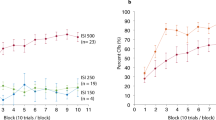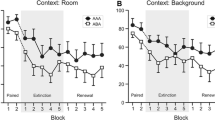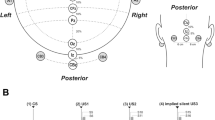Abstract
Background and aims: Classical conditioning is impaired in elderly subjects, and an experiment investigated the role of unconditioned response magnitude and autonomic arousal in this aging-related impairment. Methods: Two groups of young (n=20, mean age 23.8 years) and elderly (n=21, mean age 73.8 years) healthy subjects participated in the experiment. Single-cue classical eyeblink conditioning was in effect for 72 trials, with a tone as the conditioned stimulus (CS) and an airpuff to the eye as the unconditioned stimulus (US). The CS was presented alone in eight additional trials to allow recordings of skin conductance and heart rate responses. Startle eyeblink reflexes were elicited either alone or in the presence of the CS after the end of the conditioning procedure to investigate startle potentiation. Results: More young (95%) than elderly (76%) subjects identified the CS — US contingency in a post-conditioning questionnaire, whereas only 38% of the elderly and 85% of the young subjects acquired the conditioned response (CR). Unconditioned blink reflex magnitudes were greater in the subjects who had acquired the CR. Heart rate deceleration was seen in both young and elderly subjects who had acquired the conditioned response. Startle reflexes and skin conductance responses were related to conditioning in young but not in elderly subjects. Conclusions: Unconditioned response magnitude was the best predictor for the acquisition of the CR. Together with the questionnaire data, this indicates that peripheral factors play a significant role in the impairment of classical eyeblink conditioning in elderly people. Autonomic arousal was not related to acquisition of the CR in elderly subjects.
Similar content being viewed by others
References
Durkin M, Prescott L, Furchtgott E, Cantor J, Powell DA. Concomitant eyeblink and heart rate classical conditioning in young, middle-aged, and elderly human subjects. Psychol Aging 1993; 8: 571–81.
Solomon PR, Pomerleau D, Bennett L, James J, Morse DL. Acquisition of the classically conditioned eyeblink response over the life span. Psychol Aging 1989; 4: 34–41.
Woodruff-Pak DS, Thompson RF. Classical conditioning of the eyeblink response in the delay paradigm in adults aged 18–83 years. Psychol Aging 1988; 3: 219–29.
Woodruff-Pak DS, Finkbiner RG. Larger nondeclarative than declarative deficits in learning and memory in human aging. Psychol Aging 1995; 10: 416–26.
Grillon C, Hill J. Emotional arousal does not affect delay eyeblink conditioning. Cogn Brain Res 2003; 17: 400–5.
Spence KW. Learning and performance in eyelid conditioning as a function of intensity of the UCS. J Exp Psychol 1953; 45: 57–63.
Raten MA, Powell DA. Conditioned-reflex facilitation in young and older adults. Exp Aging Res 1998; 24: 387–410.
Finkbiner RG, Woodruff-Pak DS. Classical conditioning in adulthood: effects of age and interstimulus interval on acquisition in the trace paradigm. Psychol Aging 1991; 6: 109–17.
Raten MA. A comparison of electromyographic and photoelectric techniques in the study of classical eyeblink conditioning and startle reflex modification. J Psychophysiol 1993b; 7: 230–7.
Woodruff DS. Arousal, sleep, and aging. In Birren JE, Schaie KW, eds. Handbook of the Psychology of Aging. New York: Van Nostrand Reinhold, 1977: 261–95.
Jennings JR. Nebes R, Brock K. Memory retrieval in noise and psychophysiological response in the young and old. Psychophysiology 1988; 25: 633–44.
Boucsein W, Valentin A, Furedy JJ. Psychophysiological and behavioral differences as a function of age and Parkinson’s disease. Integ Physiol Behav Sci 1993; 28: 213–25.
Plouffe L, Stelmack RM. The electrodermal orienting response and memory: an analysis of age differences in picture recall. Psychophysiology 1984; 21: 191–8.
Furchtgott E, Busemeyer JK. Heart rate and skin conductance during cognitive processes as a function of age. J Gerontol 1979; 34: 183–90.
McDowd JM, Filion DL. Aging, selective attention, and inhibitory processes: a psychophysiological approach. Psychol Aging 1992; 7: 65–71.
Eysenck HJ, Levey AB. Konditionierung, Introversion-Extraversion und die Stärke des Nervensystems. Zeitschr Psychol 1967; 174: 96–106.
Runquist WN, Ross LE. The relationship between physiological measures of emotionality and performance in eyelid conditioning. J Exp Psychol 1959; 57: 329–32.
Spence KW, Taylor J. Anxiety and strength of the UCS as determiners of the amount of eyelid conditioning. J Exp Psychol 1951; 42: 183–8.
King MS, Kimble GA, Gorman J, King RA. Replication report: two failures to reproduce effects of anxiety on eyelid conditioning. J Exp Psychol 1961; 62: 532–3.
Raten MA. Caffeine-induced arousal modulates somatomotor and autonomic differential classical conditioning in humans. Psychopharmacology 1998; 135: 82–92.
Raten MA. Startle reflex facilitation as a function of classical eyeblink conditioning in humans. Psychophysiology 1993; 30: 581–8.
Pfeiffer E. Multidimensional Functional Assessment: the OARS methodology. Durham, NC: Duke University Center for the Study of Aging and Human Development, 1975.
Raten MA, Vaksdal A, Hugdahl K. An IBM-PC and Commodore 64 microcomputer-based system for elicitation and recording of eyeblink reflexes. Biol Psychol 1989; 29: 291–8.
Rosenthal R, Rosnow RL. Contrast Analysis. Cambridge: Cambridge University Press, 1985.
Prescott L, Durkin M, Furchtgott E, Powell DA. Concomitant heart rate and eyeblink pavlovian conditioning in human subjects as a function of interstimulus interval. Psychophysiology 1992; 29: 646–56.
Sun WS, Baker RS, Chuke JC, et al. Age-related changes in human blinks. Invest Ophthalm Visual Sci 1997; 38: 92–9.
Raten MA, Hugdahl K. Does classical eyeblink conditioning generate sensitization of the neural pathway of the conditional stimulus (CS+)? Psychobiol 1991; 19: 51–7.
Lang PJ, Bradley MM, Cuthbert BN. Emotion, attention, and the startle reflex. Psychol Rev 1990; 97: 377–95.
Tapp W, Servatius R, Hunt J, Powell DA. Vagal activity predicts eyeblink conditioning in human subjects. Neuroreport 1997; 8: 1203–7.
Putnam LE, Graham FK, Ross LE. Cardiac orienting during “good” and “poor” differential eyelid conditioning. J Exp Psychol 1975; 102: 563–73.
Martin I, Levey AB. Learning what will happen next: conditioning, evaluation, and cognitive processes. In Davey G, ed. Cognitive Processes in Pavlovian Conditioning in Humans. Chichester: John Wiley, 1987.
Author information
Authors and Affiliations
Corresponding author
Additional information
This work was presented at the “Annual Meeting of the Society for Psychophysiological Research”, Denver, CO, USA, October 1998 (Flaten MA, Friborg O. Impaired classical eyeblink conditioning in elderly subjects: The role of autonomic arousal).
Rights and permissions
About this article
Cite this article
Flaten, M.A., Friborg, O. Impaired classical eyeblink conditioning in elderly human subjects: the role of unconditioned response magnitude. Aging Clin Exp Res 17, 449–457 (2005). https://doi.org/10.1007/BF03327411
Received:
Accepted:
Published:
Issue Date:
DOI: https://doi.org/10.1007/BF03327411




